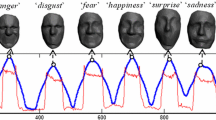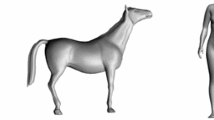Abstract
Although there have been a large body of works on computing the similarity of static shapes, similarity judgments on deforming meshes are not studied well. In this study, we investigate a similarity measurement method for comparing two deforming meshes. Based on the degree of deformation, we first binarily label each triangle within each frame as either ‘deformed’ or ‘rigid’, then merge the ‘deformed’ triangles in both spatial and temporal domains for the segmentation. The segmentation results are encoded in a form of evolving graph, with an aim of obtaining a compact representation of the motion of the mesh. Finally, we formulate the similarity measurement as a sequence matching problem: after clustering similar graphs and assigning each of the graphs with the cluster labels, each deforming mesh is represented with a sequence of labels. Then, we apply a sequence alignment algorithm to compute the locally optimal alignment between the two label sequences, and to compute the similarity by normalizing the alignment score. The experimental results over several datasets show that the similarities of animation data can be captured correctly using our approach. This may be significant, as it solves a problem that cannot be handled by current approaches.










Similar content being viewed by others
References
Autodesk Inc.: 3D Studio Max. http://www.autodesk.com/products/3ds-max/overview. Accessed 23 Nov 2015
Sumner, R., Popovic, J.: Mesh data from deformation transfer for triangle meshes. Computer Graphics Group at MIT. http://people.csail.mit.edu/sumner/research/deftransfer/data.html. Accessed 23 Nov 2015
Bronstein, A.M., Bronstein, M.M., Castellani, U., Falcidieno, B., Fusiello, A., Godil, A., Guibas, L.J., Kokkinos, I., Lian, Z., Ovsjanikov, M., Patane, G., Spagnuolo, M., Toldo, R.: Project: tools for non-rigid shape comparison and analysis. http://tosca.cs.technion.ac.il/. Accessed 23 Nov 2015
Ankerst, M., Kastenmüller, G., Kriegel, H.-P., Seidl, T.: 3d shape histograms for similarity search and classification in spatial databases. In: Advances in Spatial Databases, pp. 207–226. Springer (1999)
Attene, M., Falcidieno, B., Spagnuolo, M.: Hierarchical mesh segmentation based on fitting primitives. Vis. Comput. 22(3), 181–193 (2006)
Attene, M., Katz, S., Mortara, M., Patané, G., Spagnuolo, M., Tal, A.: Mesh segmentation—a comparative study. In: IEEE International Conference on Shape Modeling and Applications, 2006. SMI (2006)
Barton, G.J.: An efficient algorithm to locate all locally optimal alignments between two sequences allowing for gaps. Comput. Appl. Biosci.: CABIOS 9(6), 729–734 (1993)
Benhabiles, H., Lavoué, G., Vandeborre, J.-P., Daoudi, M.: Learning boundary edges for 3d-mesh segmentation. In: Computer Graphics Forum, vol. 30, pp. 2170–2182. Wiley Online Library (2011)
Budd, C., Huang, P., Klaudiny, M., Hilton, A.: Global non-rigid alignment of surface sequences. Int. J. Comput. Vis. 102(1–3), 256–270 (2013)
Chen, X., Golovinskiy, A., Funkhouser, T.: A benchmark for 3d mesh segmentation. In: ACM Transactions on Graphics (TOG), vol. 28, p. 73. ACM (2009)
Crandall, S.H., Lardner, T.J., Archer, R.R., Cook, N.H., Dahl, N.C.: An introduction to the mechanics of solids
Cyr, C.M., Kimia, B.B.: 3d object recognition using shape similarity-based aspect graph. In: Eighth IEEE International Conference on Computer Vision, 2001. ICCV 2001. Proceedings, vol. 1, pp. 254–261. IEEE (2001)
Gkalelis, N., Kim, H., Hilton, A., Nikolaidis, N., Pitas, I.: The i3dpost multi-view and 3d human action/interaction database. In: Conference for Visual Media Production, 2009. CVMP’09, pp. 159–168. IEEE (2009)
Golovinskiy, A., Funkhouser, T.: Consistent segmentation of 3d models. Comput. Gr. 33(3), 262–269 (2009)
Gusfield, D.: Algorithms on Strings, Trees and Sequences: Computer Science and Computational Biology. Cambridge University Press, Cambridge (1997)
Huang, Q., Koltun, V., Guibas, L.: Joint shape segmentation with linear programming. In: ACM Transactions on Graphics (TOG), vol. 30, p. 125. ACM (2011)
Inaba, M., Katoh, N., Imai, H.: Applications of weighted voronoi diagrams and randomization to variance-based k-clustering. In: Proceedings of the Tenth Annual Symposium on Computational Geometry, pp. 332–339. ACM (1994)
Johnson, A.E.: Spin-images: a representation for 3-D surface matching. Ph.D. thesis, Citeseer (1997)
Jolliffe, I.: Principal Component Analysis. Wiley Online Library, New York (2005)
Kalafatlar, E., Yemez, Y.: 3d articulated shape segmentation using motion information. In: 2010 20th International Conference on Pattern Recognition (ICPR), pp. 3595–3598. IEEE (2010)
Kalogerakis, E., Hertzmann, A., Singh, K.: Learning 3d mesh segmentation and labeling. ACM Trans. Gr. (TOG) 29(4), 102 (2010)
Katz, S., Leifman, G., Tal, A.: Mesh segmentation using feature point and core extraction. Vis. Comput. 21(8–10), 649–658 (2005)
Kazhdan, M., Funkhouser, T., Rusinkiewicz, S.: Rotation invariant spherical harmonic representation of 3d shape descriptors. In: Symposium on Geometry Processing, vol. 6 (2003)
Kruskall, J.B., Liberman, M.: The symmetric time warping algorithm: from continuous to discrete. In: The Theory and Practice of Sequence Comparison, in time Warps, String Edits and Macromolecules (1983)
Lee, T.-Y., Wang, Y.-S., Chen, T.-G.: Segmenting a deforming mesh into near-rigid components. Vis. Comput. 22(9–11), 729–739 (2006)
Luo, G., Cordier, F., Seo, H.: Similarity of deforming meshes based on spatio-temporal segmentation. In: 3D Object Retrieval Workshop, 3DOR (2014)
Mamou, K., Zaharia, T., Prêteux, F.: A skinning approach for dynamic 3d mesh compression. Comput. Anim. Virtual Worlds 17(3–4), 337–346 (2006)
Müller, M., Röder, T., Clausen, M.: Efficient content-based retrieval of motion capture data. In: ACM Transactions on Graphics (TOG), vol. 24, pp. 677–685. ACM (2005)
Neuhaus, M., Riesen, K., Bunke, H.: Fast suboptimal algorithms for the computation of graph edit distance. In: Structural, Syntactic, and Statistical Pattern Recognition, pp. 163–172. Springer (2006)
Riesen, K., Bunke, H.: Graph classification based on vector space embedding. Int. J. Pattern Recognit. Artif. Intell. 23(06), 1053–1081 (2009)
Riesen, K., Bunke, H.: Reducing the dimensionality of dissimilarity space embedding graph kernels. Eng. Appl. Artif. Intell. 22(1), 48–56 (2009)
Sattler, M., Sarlette, R., Klein, R.: Simple and efficient compression of animation sequences. In: Proceedings of the 2005 ACM SIGGRAPH/Eurographics Symposium on Computer Animation, pp. 209–217. ACM (2005)
Shamir, A.: A survey on mesh segmentation techniques. In: Computer Graphics Forum, vol. 27, pp. 1539–1556. Wiley Online Library (2008)
Shapira, L., Shamir, A., Cohen-Or, D.: Consistent mesh partitioning and skeletonisation using the shape diameter function. Vis. Comput. 24(4), 249–259 (2008)
Sidi, O., van Kaick, O., Kleiman, Y., Zhang, H., Cohen-Or, D.: Unsupervised co-segmentation of a set of shapes via descriptor-space spectral clustering. In: ACM Transactions on Graphics (TOG), vol. 30, p. 126. ACM (2011)
Smith, T.F., Waterman, M.S.: Identification of common molecular subsequences. J. Mol. Biol. 147(1), 195–197 (1981)
Starck, J., Hilton, A.: Surface capture for performance-based animation. Comput. Gr. Appl. IEEE 27(3), 21–31 (2007)
Stigler, S.M.: Francis Galton’s account of the invention of correlation. Stat. Sci. 4(2):73–79 (1989)
Sumner, R.W., Zwicker, M., Gotsman, C., Popović, J.: Mesh-based inverse kinematics. In: ACM Transactions on Graphics (TOG), vol. 24, pp. 488–495. ACM (2005)
Sundar, H., Silver, D., Gagvani, N., Dickinson, S.: Skeleton based shape matching and retrieval. In: Shape Modeling International, 2003, pp. 130–139. IEEE (2003)
Wang, Y., Gong, M., Wang, T., Cohen-Or, D., Zhang, H., Chen, B.: Projective analysis for 3d shape segmentation. ACM Trans. Gr. (TOG) 32(6), 192 (2013)
Wu, S., Xia, S., Wang, Z., Li, C.: Efficient motion data indexing and retrieval with local similarity measure of motion strings. Vis. Comput. 25(5–7), 499–508 (2009)
Wuhrer, S., Brunton, A.: Segmenting animated objects into near-rigid components. Vis. Comput. 26(2), 147–155 (2010)
Acknowledgments
We first would like to thank Professor Adrian Hilton and Dr. Peng Huang from the University of Surrey, for providing us a set of synthetic deforming meshes, which have been used for evaluation. We are grateful to MIRALab at the University of Geneva, who has provided us with the scanned face data. This has allowed us to make the highly resoluted facial animations “Face_2” and “Face_3” by transferring our mocap facial expressions to the scanned meshes. We would like to thank Frédéric Larue and Olivier Génevaux for providing us with the facial motion capture data, and Arash Habibi for providing us the “Horse_2” data. We also would like to thank Vasyl Mykhalchuk, who has developed a tool for visualizing the evolving graphs. This work has been jointly supported by the French national project SHARED (Shape Analysis and Registration of People Using Dynamic Data, No. 10-CHEX-014-01), and the Science and Technology Research Project of Jiangxi Provincial Department of Education (GJJ14246).
Author information
Authors and Affiliations
Corresponding author
Electronic supplementary material
Below is the link to the electronic supplementary material.
Supplementary material 1 (mov 7966 KB)
Rights and permissions
About this article
Cite this article
Luo, G., Cordier, F. & Seo, H. Spatio-temporal segmentation for the similarity measurement of deforming meshes. Vis Comput 32, 243–256 (2016). https://doi.org/10.1007/s00371-015-1178-8
Published:
Issue Date:
DOI: https://doi.org/10.1007/s00371-015-1178-8




